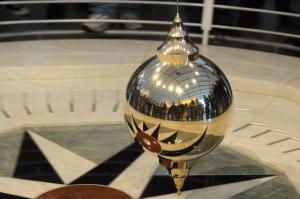Blog
The Pendulum of Truth
22 March 2015
 Flickr user Hitchster, via Wikipedia
Flickr user Hitchster, via WikipediaIn an earlier post I talked about the Titius-Bode relation, and how it had been applied to exoplanetary systems with questionable success. It’s an example of trying something just to see if it works. But sometimes an experiment produces results that are strange and unexplainable. It’s even more frustrating when further results are frustratingly inconclusive. Take, for example, the phenomenon known as the Allais effect.
 Enterprise Mission
Enterprise MissionMaurice Allais was an economist who was awarded the Nobel Prize in Economics in 1988. He also had an interest in physics, particularly some alternative approaches to gravity and electromagnetism. In 1954 he performed an experiment during a total solar eclipse, where he measured the rate at which a Foucault pendulum shifted over time.1 According to known physics, there shouldn’t be any effect at all, but Allais observed an abrupt change in the precession rate during the height of the eclipse.It came to be known as the Allais effect, or Allais anomaly. Given the unexpectedness of the result, the obvious weak point is to look at Allais’ methodology. After all, he wasn’t an experimentalist, so perhaps the result isn’t valid. But tracking the precession of a pendulum isn’t particularly difficult. Allais repeated the experiment in 1959 and again saw an anomalous result.
The results were interesting enough that others researchers have made similar experiments in the 1960s and 1970s. Some had an anomalous result, and some didn’t. Variations of the experiment have been done with a torsion pendulum (basically a horizontal bar suspended on a wire), and some verified the result and others didn’t. In 1991 a precise torsion experiment was done, and found no effect.2 Because of this the common view is that the effect isn’t real, but there are still experiments that claim to confirm the Allais effect. Since the effect requires a total eclipse, you can’t do the experiment very often, and you need to have a setup portable enough to do on site. So getting good, consistent results is difficult at best.
The debate over the Allais effect still lingers. Some argue that it isn’t a real effect, some argue that it’s a real effect, but is due to external factors such atmospheric changes of temperature, pressure and humidity which can occur during a total eclipse. Others argue that it’s a real effect, and is due to “new physics.” This latter view has become popular among supporters of alternative gravity models. Allais himself claimed that the effect was the result of new physics, though never proposed a clear mechanism. As a result, the experiment has become “tainted” by fringe science to the point that mainstream scientists don’t really do the experiment any more. The 1991 result is pretty clear, and Allais’ results are likely due to experimental error.
In 2017, when a total eclipse will cut across the entirety of the U.S., you will likely see a flurry of new experiments being done. Perhaps these new experiments might verify the result, but I wouldn’t count on it. In the end, it’s the experimental results that matter, and if there does happen to be clear results from careful experiments that find an anomalous result, then that’s the way the pendulum of truth will swing in the end.